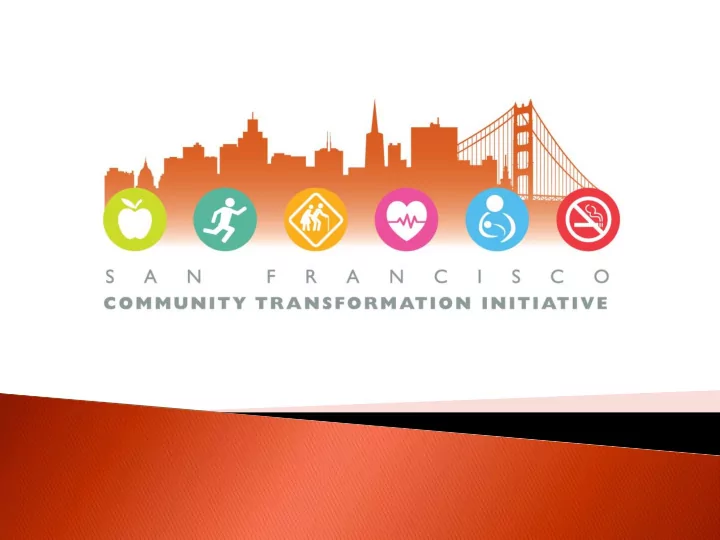

Priorities based on the National Prevention Strategy Funded by the Patient Protection and Affordable Care Act under the Prevention and Public Health Fund Collaborative approach to prevent chronic disease such as cancer, diabetes and heart disease Collaboration across multiple sectors of the community including public health, education, transportation, business and more Using collective impact to achieve healthier environments and healthier options
San Francisco Department of Health Public Health Accreditation Focus Area: Safe and Healthy Living Environments (CHIP) Headline Indicators- Percent exposed to second hand smoke CTI Measure: (1) Reduce death and disability due to tobacco use by 5% Focus Area: Healthy Eating and Physical Activity (CHIP) Headline Indicators- Percent of residents who maintain a healthy weight CTI Measure: (2) Reduce prevalence of obesity by 5% Focus Area: African-American / Black Health (DPH Priority) Headline Indicators- Percent of African-Americans with heart disease CTI Measure: (3) Reduce death and disability due to heart disease and stroke by 5%.
Leadership Council : Community residents, prevention leaders, organizational directors, business partners and others coming together to leverage the unique opportunity under the PPACA/PPHF and provide leadership and a vision for implementing effective prevention strategies that transform the health of San Francisco. ◦ Utilizing Collective Impact model ◦ Integrated into the new SFHIP Transformational Leadership Community : To create a network of leaders across San Francisco to improve and leverage existing work for greater impact. This includes: ◦ T echnical assistance from 6 national organizations including the Berkeley Media Studies Group, Public Health Foundation, Prevention Institute, Community Initiatives, and ChangeLab Solutions ◦ 10 subcontracted partners and 80% of funds out to partners in years 1-2
Safe Environments for Walking : Improve the safety and quality of the pedestrian environment and implement a Citywide Pedestrian Strategic Action Plan to increase walk trips and decrease severe and fatal pedestrian injuries. ◦ Pedestrian Safety Strategy in partnership with Environmental Health Section Healthy Mothers Workplace : Ensure equitable maternity leave and lactation accommodation policies by having a “Healthy Mothers Workplace Taskforce” develop a standardized workplace assessment and award program. ◦ Healthy Mother’s Workplace Award - Supporting and promoting breastfeeding in the workplace. 27 businesses assessed to date. Featured in U.S. News and World Report! “Healthy Apple” Child Care : Develop, implement, and assess countywide nutrition and physical activity standards in child care programs, while awarding excellence in within these programs. ◦ Healthy Apple Award - Assessing nutrition policy in daycare settings. 36 sites assessed to date!
Smoke Free Multi-Unit Housing : Increase the number of smoke-free multi-unit housing environments across San Francisco. ◦ Veterans Commons, which will provide housing for veterans in 76 units, adopted a 100% smoke-free requirement in their leases. Local Markets/Corner Stores : Increase accessibility, availability, and affordability of healthy foods in communities by supporting healthy retail through community engagement initiatives to build demand for healthy food access. ◦ Youth led campaign to drive demand for healthy food products and redesigned retail corner stores in the Bayview Joint Use of Public Schools : Create an online database to facilitate the joint use of public school spaces (e.g. school yards during non-school hours) by community groups to promote increased physical activity of residents. ◦ SFUSD launched a new online facility permit and services agreement form (MOU) which includes a sliding scale for not-for-profits.
Community Oriented Clinical Preventive Services: Support community-based primary care health centers in institute strategies to systematically assess and manage patients with hypertension and high cholesterol, and link health centers to community-based activities supporting healthy eating and active living. ◦ Recognized by CDC for clinical decision supports in DPH clinics Community Health Worker Training : Provide community health worker trainings and internships at Community Transformation Initiative sites to improve clinical and preventative services through supporting chronic disease management and linkages to community-based prevention activities. ◦ 20 new Community Health Workers being trained by City College; of San Francisco; placements began Fall 2013 ACTive Zones : Establish free daily physical activity programs for adults in every district to promote increased physical and social activity. ◦ Over 80 free physical activity opportunities in neighborhoods in over two dozen locations in partnership with Rec/Park, YMCA Neighborhood PowerPlay : Institute free, physical activity programming every afternoon for all youth in nine neighborhoods. ◦ Boys and Girls Clubs expands PowerPlay to all 9 club locations Baby Zones : Plan a network of “Baby Zones” promoting healthy infant and early childhood development, physical activity, and good parenting, as well as providing safe spaces for addressing additional parenting-related psychosocial issues. ◦ “How-to” Guidebook on BabyZones developed and disseminated
Need to sustain funding stream for chronic disease prevention. Extreme scrutiny under the PPACA/PPHF Prevention funding seen as “slush fun” nationally and “extra” at State and local levels Place/policy (HiAP) seen as “nanny-state” interventions Changing place, policy & social norms takes time. “Shifting the conversation” to proactive versus reactive/crisis communication takes time and expertise
Recommend
More recommend